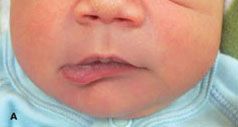Asymmetrical Crying Facies
This baby boy was born at 40 weeks’ gestation via repeated cesarean section without any distress after uncomplicated antenatal and perinatal periods. Weight was 6 lb 4 oz. Apgar scores were 9 and 9 at 1 and 5 minutes, respectively. He was noted to have lower lip asymmetry. While at rest, the lower lip protruded slightly on the right but otherwise appeared normal (A). During vigorous crying, the lower lip pulled downward to the right (B). All other physical findings were normal.
This baby boy was born at 40 weeks’ gestation via repeated cesarean section without any distress after uncomplicated antenatal and perinatal periods. Weight was 6 lb 4 oz. Apgar scores were 9 and 9 at 1 and 5 minutes, respectively. He was noted to have lower lip asymmetry. While at rest, the lower lip protruded slightly on the right but otherwise appeared normal (A). During vigorous crying, the lower lip pulled downward to the right (B). All other physical findings were normal. His family history was noncontributory.

Asymmetrical crying facies is a rare minor congenital anomaly that is the result of unilateral agenesis or hypoplasia of the depressor anguli oris muscle. The left side of the mouth is affected in nearly 80% of cases.1,2 The lip asymmetry may also be apparent when the infant smiles. Other facial features are symmetrical.
Infants with asymmetrical crying facies suck well without drooling from either corner of the mouth. This is in contrast to infants with facial nerve palsy, who generally have an asymmetric forehead and nasolabial folds and are unable to close the eye on the affected side. Ultrasonography of facial muscles and electrophysiological studies may help confirm the diagnosis.

Asymmetrical crying facies is frequently an isolated finding; however, it may be associated with cardiovascular (Cayler cardiofacial syndrome), musculoskeletal, genitourinary, and respiratory defects.1,2 Thus, it is important to consider these defects in the workup of an affected patient and to pursue testing when other abnormalities are present.
The asymmetry becomes less obvious with age as the tendency to cry decreases. Parental reassurance is usually all that is necessary.
References:
REFERENCES:
1.
Rioja-Mazza D, Lieber E, Kamath V, Kalpatthi R. Asymmetric crying facies: a possible marker for congenital malformations.
J Matern Fetal Neonat Med.
2005;18:275-277.
2.
Dubnov-Raz G, Merlob P, Geva-Dayan K, et al. Increased rate of major birth malformations in infants with neonatal “asymmetric crying face”: a hospital-based cohort study.
Am J Med Genet A.
2007;143:305-310.